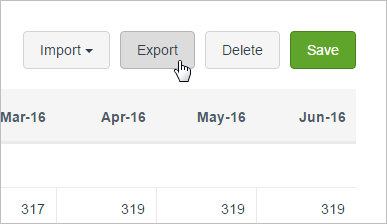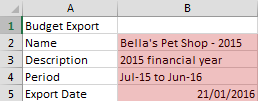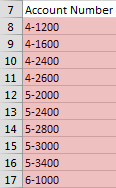- Created by StevenR, last modified by RonT on Aug 17, 2022
https://help.myob.com/wiki/x/nJWi
How satisfied are you with our online help?*
Just these help pages, not phone support or the product itself
Why did you give this rating?
Anything else you want to tell us about the help?
Want to use spreadsheet software, like Microsoft Excel, to edit your budget? It's easy to do, just follow these three steps:
- Export your MYOB Essentials budget as a CSV (comma-separated values) file.
- Edit the budget using spreadsheet software.
- Import the budget back into MYOB Essentials.
There are some things to note before you get started - read on for information about the process.
1. Export your budget
To avoid issues, you should always start by exporting your current budget - even if it's blank - to a CSV file. This ensures that the formatting and content of the file is correct and complete.
To export the budget
- Go to the Reports menu and choose Budgets.
- Click to open the budget you want to export.
- Click Export. The budget is downloaded as a CSV file to your computer.

2. Edit your budget
After exporting the CSV file, open it using Microsoft Excel (or your preferred spreadsheet software) and you'll see there are two sections to the budget, the header and the budget items. There are some restrictions to what you can edit.
Budget header
Any changes you make to the fields in the budget header - Name, Description, Period and Export Date - will be ignored, so you shouldn't make any changes to this section of the budget.

Budget items
The budget items section contains the columns and rows of information listing the budget values for each month of the budget. You can type over the amounts that were exported, or use formulas to calculate the amounts. However, some formatting can cause the file to not import successfully into MYOB Essentials, so note the following:
- Adding columns and rows: Don't add new columns or rows to the area highlighted below. If columns or rows are added to this budget editing area, you won't be able to import the file into MYOB Essentials.

- Column labels (Row 7): You can't change the information that appears on row 7 (the column headers), and you can't add other information to that row either.

- Account Number column: Don't change any of the account numbers, or the order of the account numbers. These must match the accounts list that appears in your budget within MYOB Essentials.

- Account balances: The only values you may enter in account balance cells are zero, or positive and negative numbers. Blank fields are allowed, but alphabetic characters and special characters are not.
- Negative numbers: For account balances with negative values, always use a hyphen, not parenthesis, otherwise the file can't be imported.

- Decimal numbers: You can enter decimal values in the account balances, but they will be rounded to the nearest dollar once the file is imported.
3. Import the CSV file
When you're done editing the file, you can import it. Note that when you import a CSV file, it will overwrite the amounts that are already recorded in the budget.
Ensure that the file you import into MYOB Essentials is a valid CSV file. It needs to have a .csv extension.
Also, Microsoft Excel files can't be imported, even if you change the file's extension to csv. If you've worked on your budget using Excel, you need to save it as a CSV file.
To import the budget
- Go to the Reports menu choose Budgets.
- Click to open the budget that the CSV file applies to. The budget's period must match the periods included in the CSV file.
- Click Import > Import CSV .

- Click Browse and select the CSV file you want to import.

- Click Import & overwrite. Your CSV file is imported into your budget.

 Yes
Yes
 No
No
 Thanks for your feedback.
Thanks for your feedback.